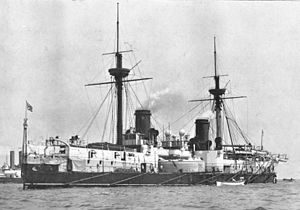
Back Inflexible (Schiff, 1881) German اچاماس اینفلکسیبل (۱۸۷۶) Persian HMS Inflexible (1876) Finnish HMS Inflexible (1876) French インフレキシブル (装甲艦) Japanese HMS Inflexible (1876) Polish HMS Inflexible (1876) Russian
 HMS Inflexible with the pole masts fitted in 1885,[1] replacing the original full sailing rig
| |
| Class overview | |
|---|---|
| Preceded by | HMS Dreadnought (1875)[2] |
| Succeeded by | Ajax class |
| History | |
| Builder | Portsmouth Dockyard |
| Cost | £812,000 |
| Laid down | 24 February 1874 |
| Launched | 27 April 1876 |
| Commissioned | 5 July 1881 |
| Fate | Scrapped 1903 |
| General characteristics | |
| Displacement |
|
| Length |
|
| Beam | 75 ft (23 m) |
| Draught | 26.3 ft (8.0 m) |
| Propulsion | 12 coal-fired boilers, two single-expansion Elder and Co. steam engines, 2 twin-bladed 20 ft (6.1 m) diameter screws |
| Speed | 14.73 knots (27 km/h) @ 6,500 hp (4.8 MW) |
| Range | "Cross-Atlantic at economical speed" |
| Complement | 440–470 |
| Armament |
|
| Armour |
|
HMS Inflexible was a Victorian ironclad battleship carrying her main armament in centrally placed turrets. The ship was constructed in the 1870s for the Royal Navy to oppose the perceived growing threat from the Italian Regia Marina in the Mediterranean.
The Italian Navy had started constructing a pair of battleships, Duilio and Enrico Dandolo, equipped with four Armstrong 17.7-inch (450 mm) guns weighing 100 tons each. These were superior to the armament of any ship in the British Mediterranean Squadron, and Inflexible was designed as a counter to them.
Inflexible mounted larger guns than those of any previous British warship and had the thickest armour ever to be fitted to a Royal Navy ship. Controversially, she was designed so that if her un-armoured ends should be seriously damaged in action and become water-logged, the buoyancy of the armoured centre section of the ship would keep her afloat and upright.
The ship was the first major warship to depend in part for the protection of her buoyancy on a horizontal armoured deck below the water-line rather than armoured sides along the waterline.
- ^ David K. Brown (1997). Warrior to Dreadnought – Warship development 1860–1905. Chatham Publishing. p. 65. ISBN 1-84067-529-2.
- ^ Jane & Wyllie 1915, pp. 312–317.
© MMXXIII Rich X Search. We shall prevail. All rights reserved. Rich X Search